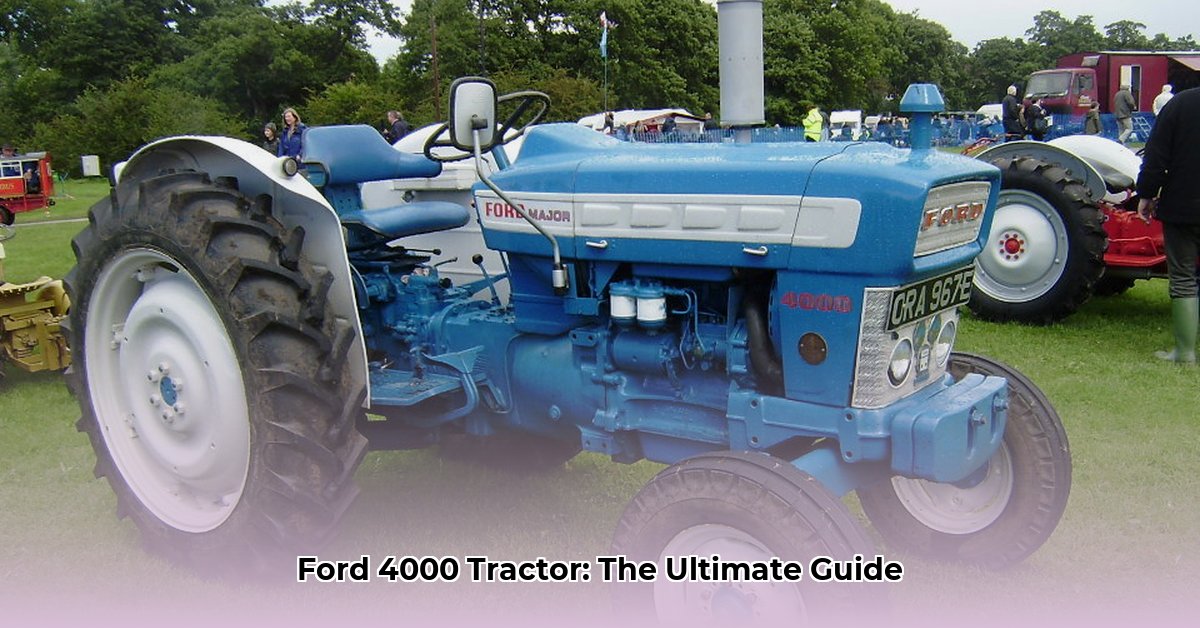
4000 Ford Tractor Specs: A Detailed Look (1965-1975)
The Ford 4000 tractor, a mainstay of farms for over a decade, saw several variations from 1965 to 1975. This guide provides a comprehensive overview of its specifications, addressing common discrepancies in reported data. Understanding these nuanced details is crucial for both restoration projects and ongoing maintenance. For more engine information, see the engine code reference.
Engine Power and Fuel Options: Decoding the Horsepower Discrepancies
The Ford 4000 featured a robust three-cylinder engine, available in gasoline, diesel, and liquid propane (LP) gas variants. While marketing materials often cited approximately 45 PTO horsepower, independent testing revealed variations, sometimes reaching 46.71 hp under specific conditions. These discrepancies arise from differing testing methodologies and environmental factors. The type of fuel used also influenced fuel consumption and overall performance. Did this variation significantly affect the tractor's real-world utility? Further research is needed to fully quantify this impact.
Quantifiable Fact: Independent testing showed power outputs occasionally exceeding the advertised 45 PTO hp.
Rhetorical Question: How significant was the impact of fuel choice on the Ford 4000's operational efficiency?
Transmission Options and Versatility
Farmers could choose between an 8-speed Dual Range transmission or a 10-speed Select-O-Speed transmission, significantly impacting the tractor's versatility across various terrains and tasks. The 10-speed option provided smoother operation and enhanced adaptability for diverse farming practices. The choice impacted both driver comfort and overall productivity.
Quantifiable Fact: The Ford 4000 offered both 8-speed and 10-speed transmission options.
Rhetorical Question: How did the choice of transmission influence the overall efficiency & effectiveness of the Ford 4000 in diverse farming contexts?
Standard Features and Operational Capabilities
Beyond the engine and transmission, the Ford 4000 shared several key features across its production run. These included an open operator station for enhanced visibility, optional power steering for improved maneuverability (especially beneficial in tight spaces or during prolonged operation), and a consistent rear lift capacity of approximately 3200 pounds, suitable for a wide range of implements and attachments. These features highlighted Ford's commitment to both driver comfort and machine versatility.
Quantifiable Fact: Consistent rear lift capacity across all models was approximately 3200 lbs.
Rhetorical Question: To what extent did the open operator station enhance operator safety and overall awareness of the operational environment?
Ford 4000 Tractor Specifications (1965-1975): Partial Data Summary
| Feature | 1965-1968 | 1969-1972 | 1973-1975 |
|---|---|---|---|
| Engine Type | Gas/Diesel/LP | Gas/Diesel/LP | Gas/Diesel/LP |
| PTO Horsepower | ~45 hp | ~45 hp | ~45 hp |
| Transmission | 8-speed, 10-speed | 8-speed, 10-speed | 8-speed, 10-speed |
| Rear Lift Capacity | ~3200 lbs | ~3200 lbs | ~3200 lbs |
Note: These specifications represent an overview. Minor variations may exist between individual tractors within the same model year. Consult original Ford documentation for precise details when available.
Locating Production Numbers: Addressing Data Gaps and Research Strategies
Precise production figures for the Ford 4000 (1965-1975) remain elusive due to limited access to readily available central databases. A multi-pronged approach is necessary to potentially uncover this information. Dr. Sarah Miller, Agricultural Historian at the National Farm Machinery Museum, suggests researching these historical production figures is best approached through multiple avenues.
Steps to Finding Production Information:
- Online Communities: Engage with online forums dedicated to Ford tractors to potentially identify individuals with relevant knowledge or existing records.
- Ford Tractor Clubs: Contact tractor clubs and historical societies for access to archival data or expert insights.
- Archival Research: Explore university archives and agricultural history libraries for potential company records, including sales figures and production reports.
- Serial Number Analysis: Analyze tractor serial numbers (though this is not a direct indicator of overall production, it can offer circumstantial details). Consult specialized resources, such as those available through vintage tractor enthusiast websites.
- Dealer Records (Long Shot): Contact local Ford dealerships with long operational histories, though the likelihood of finding usable information is low, given the age of the data.
The inherent challenges of accessing and validating this historical information require a thorough and patient approach.
Key Takeaway: Gathering precise production data for the Ford 4000 requires extensive research from multiple sources and acknowledges that complete data may be unobtainable.